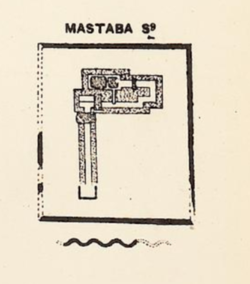S 9 (Abydos)
| S9 | |||
|---|---|---|---|
| Burial site of Neferhotep I(?) | |||

Plan of tomb S9 as drawn by Ayrton, Weigall and Petrie, who thought it was a mastaba
|
|||
| Coordinates | 26°10′17″N 31°55′30″E / 26.17139°N 31.92500°ECoordinates: 26°10′17″N 31°55′30″E / 26.17139°N 31.92500°E | ||
| Location | Abydos, Egypt | ||
| Discovered | 1901–02 | ||
| Excavated by | |||
| Layout | Enclosure wall surrouding subterranean chambers, now exposed, possibly once capped by a pyramid | ||
|
|
|||
S 9 (also Abydos-south S9) is the modern name given to a monumental ancient Egyptian tomb complex at Abydos in Egypt. The tomb is most likely royal and dates to the mid-13th Dynasty, during the late Middle Kingdom. Finds from the area of the tomb indicate that S9 suffered extensive, state-sanctioned stone and grave robbing during the Second Intermediate Period, only a few decades after its construction, as well as during the later Roman and Coptic periods. Although no direct evidence was found to determine the tomb owner, strong indirect evidence suggest that the neighbouring and slightly smaller tomb S10 belongs to pharaoh Sobekhotep IV (fl. c. 1725 BC). Consequently, S9 has been tentatively attributed by the Egyptologist Josef W. Wegner to Sobekhotep IV's predecessor and brother, Neferhotep I (fl. c. 1735 BC). According to Wegner, the tomb might originally have been capped by a pyramid.
Tomb S9 is part of a royal necropolis dating back to the late Middle Kingdom – Second Intermediate Period, which is located immediately northeast of the causeway leading to the much bigger funerary complex of Senusret III of the 12th Dynasty, close to the ancient town of Wah-Sut and at the foot of the so-called Mountain of Anubis, a natural hill in the form of a pyramid. It was first summarily explored by Émile Amélineau and subsequently excavated by Ayrton, Weigall and Petrie in 1901—1902. The tomb was covered in sand and proved to have been heavily disturbed, for example, the stone roof of the subterranean chambers had been plundered.
...
Wikipedia

